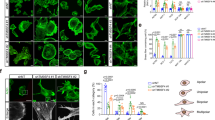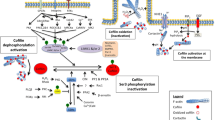Abstract
Alpha-1-syntrophin (SNTA1) and Rac1 are part of a signaling pathway via the dystrophin glycoprotein complex (DGC). Both SNTA1 and Rac1 proteins are over-expressed in various carcinomas. It is through the DGC signaling pathway that SNTA1 has been shown to act as a link between the extra cellular matrix, the internal cell signaling apparatus and the actin cytoskeleton. SNTA1 is involved in the modulation of the actin cytoskeleton and actin reorganization. Rac1 also controls actin cytoskeletal organization in the cell. In this study, we present the interplay between f-actin, SNTA1 and Rac1. We analyzed the effect of actin depolymerization on SNTA1 tyrosine phosphorylation and Rac1 activity using actin depolymerizing drugs, cytochalasin D and latrunculin A. Our results indicate a marked decrease in the tyrosine phosphorylation of SNTA1 upon actin depolymerization. Results suggest that actin depolymerization mediated loss of SNTA1 phosphorylation leads to loss of interaction between SNTA1 and Rac1, with a concomitant loss of Rac1 activation. The loss of SNTA1tyrosine phosphorylation and Rac1 activity by actin depolymerization results in increased apoptosis, decreased cell migration and decreased reactive oxygen species (ROS) levels in breast carcinoma cells. Collectively, our results present a possible role of f-actin in the SNTA1-Rac1 signaling pathway and implications of actin depolymerization on cell migration, ROS production and apoptosis.







Similar content being viewed by others
References
Sheng M, Sala C (2001) PDZ domains and the organization of supramolecular complexes. Annu Rev Neurosci 24:1–29
Adams ME, Dwyer TM, Dowler LL, White RA, Froehner SC (1995) Mouse alpha 1- and beta 2-syntrophin gene structure, chromosome localization, and homology with a discs large domain. J Biol Chem 270:25859–25865
Ahn AH, Yoshida M, Anderson MS et al (1994) Cloning of human basic A1, a distinct 59-kDa dystrophin-associated protein encoded on chromosome 8q23-24. Proc Natl Acad Sci USA 91:4446–4450
Adams ME, Butler MH, Dwyer TM, Peters MF, Murnane AA, Froehner SC (1993) Two forms of mouse syntrophin, a 58 kd dystrophin-associated protein, differ in primary structure and tissue distribution. Neuron 11:531–540
Yang B, Ibraghimov-Beskrovnaya O, Moomaw CR, Slaughter CA, Campbell KP (1994) Heterogeneity of the 59-kDa dystrophin-associated protein revealed by cDNA cloning and expression. J Biol Chem 269:6040–6044
Ahn AH, Kunkel LM (1993) The structural and functional diversity of dystrophin. Nat Genet 3:283–291
Piluso G, Mirabella M, Ricci E et al (2000) Gamma1- and gamma2-syntrophins, two novel dystrophin-binding proteins localized in neuronal cells. J Biol Chem 275:15851–15860
Ahn AH, Kunkel LM (1995) Syntrophin binds to an alternatively spliced exon of dystrophin. J Cell Biol 128:363–371
Kramarcy NR, Vidal A, Froehner SC, Sealock R (1994) Association of utrophin and multiple dystrophin short forms with the mammalian M(r) 58,000 dystrophin-associated protein (syntrophin). J Biol Chem 269:2870–2876
Hoffman EP, Brown RH Jr, Kunkel LM (1987) Dystrophin: the protein product of the Duchenne muscular dystrophy locus. Cell 51:919–928
Campbell KP, Kahl SD (1989) Association of dystrophin and an integral membrane glycoprotein. Nature 338:259–262
Butler MH, Douville K, Murnane AA et al (1992) Association of the Mr 58,000 postsynaptic protein of electric tissue with Torpedo dystrophin and the Mr 87,000 postsynaptic protein. J Biol Chem 267:6213–6218
Ahn AH, Freener CA, Gussoni E, Yoshida M, Ozawa E, Kunkel LM (1996) The three human syntrophin genes are expressed in diverse tissues, have distinct chromosomal locations, and each bind to dystrophin and its relatives. J Biol Chem 271:2724–2730
Bhat HF, Baba RA, Bashir M et al (2011) Alpha-1-syntrophin protein is differentially expressed in human cancers. Biomarkers 16:31–36
Adams ME, Kramarcy N, Krall SP et al (2000) Absence of alpha-syntrophin leads to structurally aberrant neuromuscular synapses deficient in utrophin. J Cell Biol 150:1385–1398
Petrof BJ, Shrager JB, Stedman HH, Kelly AM, Sweeney HL (1993) Dystrophin protects the sarcolemma from stresses developed during muscle contraction. Proc Natl Acad Sci USA 90:3710–3714
Abramovici H, Hogan AB, Obagi C, Topham MK, Gee SH (2003) Diacylglycerol kinase-zeta localization in skeletal muscle is regulated by phosphorylation and interaction with syntrophins. Mol Biol Cell 14:4499–4511
Hogan A, Yakubchyk Y, Chabot J et al (2004) The phosphoinositol 3,4-bisphosphate-binding protein TAPP1 interacts with syntrophins and regulates actin cytoskeletal organization. J Biol Chem 279:53717–53724
Cantley LC (2002) The phosphoinositide 3-kinase pathway. Science 296:1655–1657
Madhavan R, Massom LR, Jarrett HW (1992) Calmodulin specifically binds three proteins of the dystrophin-glycoprotein complex. Biochem Biophys Res Commun 185:753–759
Iwata Y, Sampaolesi M, Shigekawa M, Wakabayashi S (2004) Syntrophin is an actin-binding protein the cellular localization of which is regulated through cytoskeletal reorganization in skeletal muscle cells. Eur J Cell Biol 83:555–565
Bhat HF, Adams ME, Khanday FA (2013) Syntrophin proteins as Santa Claus: role(s) in cell signal transduction. Cell Mol Life Sci 70:2533–2554
Kimber WA, Trinkle-Mulcahy L, Cheung PC et al (2002) Evidence that the tandem-pleckstrin-homology-domain-containing protein TAPP1 interacts with Ptd(3,4)P2 and the multi-PDZ-domain-containing protein MUPP1 in vivo. Biochem J 361:525–536
Dowler S, Currie RA, Downes CP, Alessi DR (1999) DAPP1: a dual adaptor for phosphotyrosine and 3-phosphoinositides. Biochem J 342(Pt 1):7–12
Dowler S, Currie RA, Campbell DG et al (2000) Identification of pleckstrin-homology-domain-containing proteins with novel phosphoinositide-binding specificities. Biochem J 351:19–31
Marshall AJ, Krahn AK, Ma K, Duronio V, Hou S (2002) TAPP1 and TAPP2 are targets of phosphatidylinositol 3-kinase signaling in B cells: sustained plasma membrane recruitment triggered by the B-cell antigen receptor. Mol Cell Biol 22:5479–5491
Hasegawa M, Cuenda A, Spillantini MG et al (1999) Stress-activated protein kinase-3 interacts with the PDZ domain of alpha1-syntrophin. A mechanism for specific substrate recognition. J Biol Chem 274:12626–12631
Oak SA, Russo K, Petrucci TC, Jarrett HW (2001) Mouse alpha1-syntrophin binding to Grb2: further evidence of a role for syntrophin in cell signaling. Biochemistry 40:11270–11278
Oak SA, Zhou YW, Jarrett HW (2003) Skeletal muscle signaling pathway through the dystrophin glycoprotein complex and Rac1. J Biol Chem 278:39287–39295
Bhat HF, Baba RA, Adams ME, Khanday FA (2014) Role of SNTA1 in Rac1 activation, modulation of ROS generation, and migratory potential of human breast cancer cells. Br J Cancer 110:706–714
Ridley AJ, Schwartz MA, Burridge K et al (2003) Cell migration: integrating signals from front to back. Science 302:1704–1709
Nobes CD, Hall A (1999) Rho GTPases control polarity, protrusion, and adhesion during cell movement. J Cell Biol 144:1235–1244
Kraynov VS, Chamberlain C, Bokoch GM, Schwartz MA, Slabaugh S, Hahn KM (2000) Localized Rac activation dynamics visualized in living cells. Science 290:333–337
Ridley AJ (2001) Rho GTPases and cell migration. J Cell Sci 114:2713–2722
Benitah SA, Valeron PF, van Aelst L, Marshall CJ, Lacal JC (2004) Rho GTPases in human cancer: an unresolved link to upstream and downstream transcriptional regulation. Biochim Biophys Acta 1705:121–132
Choi UJ, Jee BK, Lim Y, Lee KH (2009) KAI1/CD82 decreases Rac1 expression and cell proliferation through PI3K/Akt/mTOR pathway in H1299 lung carcinoma cells. Cell Biochem Funct 27:40–47
Bishop AL, Hall A (2000) Rho GTPases and their effector proteins. Biochem J 348(Pt 2):241–255
Whaley-Connell AT, Morris EM, Rehmer N et al (2007) Albumin activation of NAD(P)H oxidase activity is mediated via Rac1 in proximal tubule cells. Am J Nephrol 27:15–23
Ellenbroek SI, Collard JG (2007) Rho GTPases: functions and association with cancer. Clin Exp Metastasis 24:657–672
Vega FM, Ridley AJ (2008) Rho GTPases in cancer cell biology. FEBS Lett 582:2093–2101
Fritz G, Just I, Kaina B (1999) Rho GTPases are over-expressed in human tumors. Int J Cancer 81:682–687
Schnelzer A, Prechtel D, Knaus U et al (2000) Rac1 in human breast cancer: overexpression, mutation analysis, and characterization of a new isoform, Rac1b. Oncogene 19:3013–3020
Wang J, Rao Q, Wang M et al (2009) Overexpression of Rac1 in leukemia patients and its role in leukemia cell migration and growth. Biochem Biophy Res Commun 386:769–774
Wertheimer E, Gutierrez-Uzquiza A, Rosemblit C, Lopez-Haber C, Sosa MS, Kazanietz MG (2012) Rac signaling in breast cancer: a tale of GEFs and GAPs. Cell Signal 24:353–362
Schliwa M (1982) Action of cytochalasin D on cytoskeletal networks. J Cell Biol 92:79–91
Brown SS, Spudich JA (1981) Mechanism of action of cytochalasin: evidence that it binds to actin filament ends. J Cell Biol 88:487–491
Casella JF, Flanagan MD, Lin S (1981) Cytochalasin D inhibits actin polymerization and induces depolymerization of actin filaments formed during platelet shape change. Nature 293:302–305
Pelham RJ Jr, Wang Y (1999) High resolution detection of mechanical forces exerted by locomoting fibroblasts on the substrate. Mol Biol Cell 10:935–945
Coue M, Brenner SL, Spector I, Korn ED (1987) Inhibition of actin polymerization by latrunculin A. FEBS Lett 213:316–318
Konishi H, Kikuchi S, Ochiai T et al (2009) Latrunculin a has a strong anticancer effect in a peritoneal dissemination model of human gastric cancer in mice. Anticancer Res 29:2091–2097
Wakatsuki T, Schwab B, Thompson NC, Elson EL (2001) Effects of cytochalasin D and latrunculin B on mechanical properties of cells. J Cell Sci 114:1025–1036
Acknowledgments
This work was supported by Deanship of Research, King Fahd University of Petroleum and Minerals, through the start-up grant scheme to Dr. Firdous A. Khanday, No. SR141006. It was partly financed by a grant to SSB by the University Grants Commission of India, No F. 17-82/2008(SA-I) to SSB. We are grateful to Dr. KS Siddiqui and A Ismail, for carrying out the scientific content and language editing of the manuscript.
Author information
Authors and Affiliations
Corresponding author
Ethics declarations
Conflict of interest
The authors declare no conflicts of interest.
Rights and permissions
About this article
Cite this article
Bhat, S.S., Parray, A.A., Mushtaq, U. et al. Actin depolymerization mediated loss of SNTA1 phosphorylation and Rac1 activity has implications on ROS production, cell migration and apoptosis. Apoptosis 21, 737–748 (2016). https://doi.org/10.1007/s10495-016-1241-6
Published:
Issue Date:
DOI: https://doi.org/10.1007/s10495-016-1241-6




